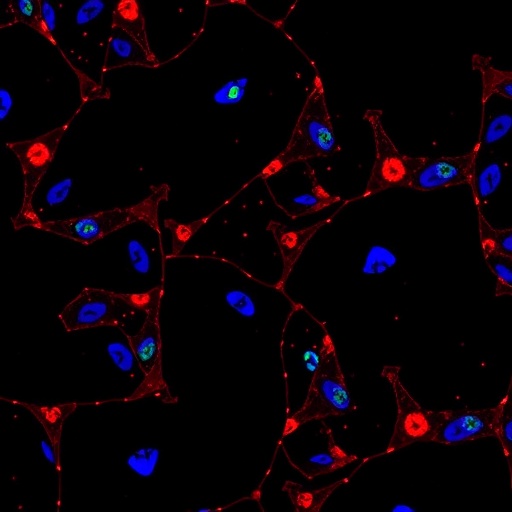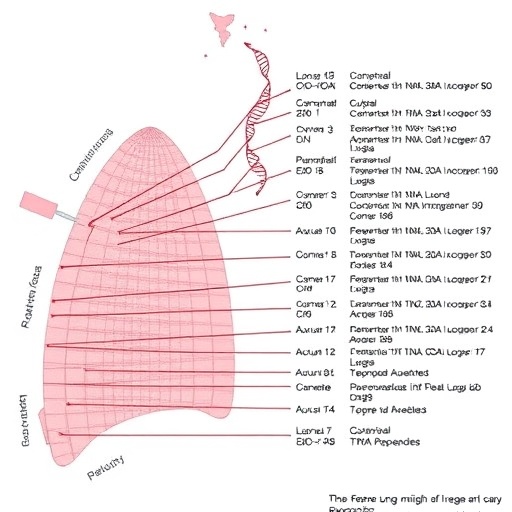A groundbreaking discovery in the field of hematologic malignancies has emerged from a recent study investigating the molecular underpinnings of acute myeloid leukemia (AML). Researchers have unveiled the potent antiproliferative and pro-apoptotic effects of an innovative antisense oligonucleotide molecule, specifically an LNA GapmeR, designed to target the noncoding RNA hsa-piR-33195. This novel therapeutic strategy marks a significant leap forward in the ongoing battle against AML, a highly aggressive and often treatment-resistant blood cancer. The implications of this research could redefine how molecularly targeted therapies are developed and implemented in clinical oncology.
Acute myeloid leukemia remains one of the most challenging hematological cancers, characterized by the rapid proliferation of abnormal myeloid progenitor cells in the bone marrow, which interfere with normal hematopoiesis. Standard chemotherapy regimens, although initially effective, frequently lead to relapse and resistance, underscoring the urgent need for more precise and durable treatments. Modern research has shifted towards the exploration of noncoding RNAs—particularly piwi-interacting RNAs (piRNAs)—which until recently were relatively unexplored in the context of leukemia pathobiology. The study in question has illuminated the role of hsa-piR-33195, a specific piRNA, in sustaining leukemic cell survival and proliferation.
The crux of this pioneering research lies in the utilization of locked nucleic acid (LNA) modified antisense GapmeRs, a class of oligonucleotides known for their high binding affinity and enhanced stability. By designing LNA GapmeRs to selectively bind and inhibit hsa-piR-33195, the investigators have been able to downregulate this piRNA, thereby disrupting its oncogenic functions. These synthetic molecules work by inducing RNase H-mediated cleavage of their target RNA, effectively silencing aberrant gene expression pathways that contribute to malignancy. This targeted approach offers a compelling advantage over traditional chemotherapies, which often lack specificity and inflict widespread cytotoxic effects.
The research team commenced their study by profiling piRNA expression patterns in various AML patient samples and cell lines, identifying hsa-piR-33195 as significantly overexpressed in leukemic cells compared to healthy hematopoietic counterparts. Functional assays revealed that this piRNA supports proliferative signaling and resists apoptosis, conferring a survival advantage to malignant cells. Interference with piRNA function via antisense LNA GapmeRs thus represented a logical and mechanistically informed therapeutic intervention. The design and optimization of these oligonucleotides involved rigorous biochemical and cell-based validation steps to ensure efficacy and minimize off-target effects.
In vitro experiments demonstrated that treatment of AML cell lines with hsa-piR-33195-targeting GapmeRs resulted in a profound reduction in cell viability. Notably, this decline was accompanied by hallmarks of programmed cell death, including mitochondrial membrane depolarization, caspase activation, and DNA fragmentation. These findings confirm that the blockade of piRNA-mediated signaling pathways is sufficient to initiate intrinsic apoptotic cascades in leukemic cells. Such insights highlight the critical dependence of AML cells on noncoding RNA networks for survival, revamping our understanding of leukemogenesis.
Further mechanistic investigations delved into downstream targets of hsa-piR-33195, uncovering that this piRNA likely modulates gene expression by interacting with RNA binding proteins and affecting mRNA stability or translation. The suppression of hsa-piR-33195 influenced key cellular pathways related to cell cycle progression and apoptosis regulation, reinforcing the multifaceted role of piRNAs beyond their classical function in germline maintenance. This paradigm shift in the conceptualization of piRNAs underscores their emerging significance in somatic cancers.
The research outcomes also emphasize the therapeutic promise of LNA GapmeRs as a platform technology. Their superior pharmacokinetic properties, including resistance to nuclease degradation and enhanced tissue penetration, make them ideal candidates for in vivo applications. The targeted delivery of GapmeRs to leukemic cells, potentially via nanoparticle conjugates or ligand-mediated uptake, could facilitate their translation from bench to bedside. The study paves the way for preclinical animal model evaluations and subsequent clinical trials, aiming to establish safety, dosage parameters, and combinatory regimens with existing therapies.
Importantly, the selective targeting of hsa-piR-33195 spares normal hematopoietic progenitors, minimizing collateral damage—a paramount consideration in hematologic malignancy treatment. This selective cytotoxicity hints at an improved therapeutic index, possibly reducing adverse effects commonly associated with systemic chemotherapy such as myelosuppression and immunosuppression. Additionally, the antisense technology offers flexibility to rapidly adapt to other oncogenic noncoding RNAs identified in diverse leukemia subtypes, opening a new frontier in precision medicine.
This research heralds a new era wherein noncoding RNAs like piRNAs transcend their traditional boundaries as regulatory molecules confined to the germline, now recognized as pivotal players in cancer biology. The exploitation of antisense LNA GapmeRs to inhibit pathogenic piRNAs promises to mitigate resistance mechanisms while inducing apoptosis, thereby tackling two major hurdles in AML treatment. Given the notorious relapse rates and dismal prognosis associated with refractory AML, these results furnish a compelling rationale to expedite the development of RNA-targeted therapeutics.
Moreover, the methodology employed offers a blueprint for integrating cutting-edge molecular biology techniques with translational oncology. Employing high-throughput sequencing, bioinformatics, and gene editing facilitated the precise identification and modulation of hsa-piR-33195. This interdisciplinary synergy exemplifies how fundamental science can efficiently fuel drug discovery pipelines, fostering the creation of highly specific molecular interventions whose effects can be directly traced to defined cellular mechanisms.
The therapeutic implications extend beyond AML alone, as noncoding RNAs have been implicated broadly across cancer types in regulating tumor proliferation, metastasis, and stemness properties. Thus, the execution of antisense LNA GapmeRs could be strategically adapted to target various malignancies characterized by aberrant piRNA expression profiles. The versatility and specificity inherent in this approach align well with the overarching goals of personalized medicine—maximizing efficacy while minimizing toxicity.
Despite these promising advances, challenges remain in ensuring efficient delivery to bone marrow niches and overcoming potential immunogenicity associated with oligonucleotide therapeutics. Future research will need to investigate combinatory strategies that pair antisense GapmeR therapy with immune checkpoint inhibitors or conventional chemotherapeutics to surmount microenvironmental resistance and enhance durable remission. Longitudinal studies examining the evolution of piRNA expression throughout disease progression and treatment may also reveal critical windows for intervention.
In conclusion, the study spearheaded by Shiri and colleagues delineates a novel and sophisticated approach to combat acute myeloid leukemia by targeting hsa-piR-33195 with antisense LNA GapmeRs. This strategy not only elucidates new aspects of leukemia pathobiology but also provides a promising foundation for the development of precision RNA-based therapeutics. As the cancer research community intensifies efforts to decode the complex RNA regulatory networks driving malignancies, approaches like this will be instrumental in overcoming some of the most formidable barriers to curing aggressive cancers such as AML.
This pioneering work signifies a paradigm shift, reframing piRNAs from enigmatic small RNAs to viable therapeutic targets and emphasizing the transformative potential of antisense technologies. The field eagerly anticipates subsequent in vivo validation and clinical assessment to confirm these initial findings and establish new standards in leukemia treatment. Harnessing the power of RNA biology to induce selective apoptosis in cancer cells promises to rewrite the future narrative of hematologic oncology, offering renewed hope to patients worldwide.
Subject of Research: Acute Myeloid Leukemia and antisense LNA GapmeR targeting noncoding RNA hsa-piR-33195.
Article Title: Antisense LNA GapmeR targeting hsa-piR-33195 induces antiproliferative and apoptotic effects on human acute myeloid leukemia.
Article References:
Shiri, M., Sharifi, M., Dianat-Moghadam, H. et al. Antisense LNA GapmeR targeting hsa-piR-33195 induces antiproliferative and apoptotic effects on human acute myeloid leukemia. Med Oncol 42, 474 (2025). https://doi.org/10.1007/s12032-025-03015-6
Image Credits: AI Generated
Tags: acute myeloid leukemia research advancementsantiproliferative effects in leukemia cellsantisense oligonucleotide therapyhematologic cancer treatment breakthroughshsa-piR-33195 targeting in AMLinnovative therapies in clinical oncologyLNA GapmeR for leukemia treatmentmolecularly targeted therapies for blood cancernoncoding RNA in hematologic malignanciesovercoming chemotherapy resistance in AMLpiwi-interacting RNAs in leukemiapro-apoptotic strategies for cancer





